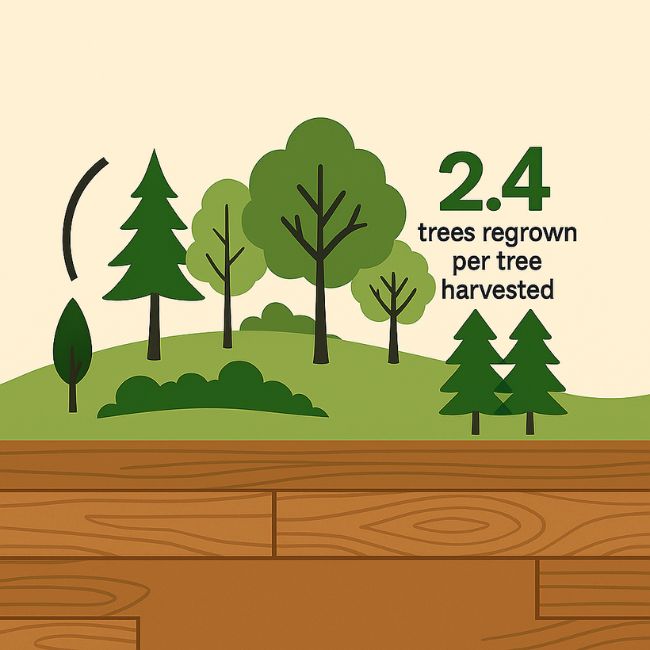When it comes to sustainable design, the materials you specify matter. Making sustainable environmental choices in our personal lives is important, but most of us have a much greater impact on the environment through the choices we make at work.
As an avid fly fisherman, it’s important to me on a personal level that I share products with our customers that have a positive impact on our environment. I want my great-grandchildren to have the same access to rivers and forests that I enjoy.
Real wood flooring stands out not just for its natural beauty, but for its strong environmental credentials. From renewability and low embodied carbon to exceptional longevity and indoor air quality benefits, wood offers commercial designers a versatile and eco-conscious option that meets both performance and sustainability goals.
Whether you're working on a high-traffic hospitality space, an upscale multifamily development, or a refined corporate interior, here’s why real wood flooring deserves a closer look.
I’m a CEU Presenter for the National Wood Flooring Association (NWFA), the industry’s leading resource for wood flooring education and standards. The insights shared in this article are drawn from coursework developed by the NWFA.

A Renewable, Low-Impact Material
Wood is the only renewable flooring material on the market. Trees are a natural resource that regrow—often faster than they’re harvested. In fact, according to the USDA Forest Service, for every tree harvested in the U.S., 2.4 more are regrown. Thanks to responsible forest management, the standing hardwood volume in the U.S. has more than doubled since the 1950s.
The Power of Refinishing
One of the most significant environmental benefits of wood flooring is its longevity. Unlike synthetic flooring options that must be torn out and replaced when worn, real wood can be sanded and refinished. This means:
- Less landfill waste
- Fewer raw materials used over time
- Lower embodied carbon
- Lower CO2 emissions during transportation
- Adaptable to changing aesthetic preferences
A study by the Swedish Environmental Research Institute found that refinishing a wood floor instead of replacing it can result in up to 79% lower carbon emissions and 95% less energy consumption. That’s a powerful argument for lifecycle sustainability.

Lower Impact from Start to Finish
From harvest to end-of-life, wood flooring performs well in life cycle assessments (LCAs).
- Uses less water and energy to produce
- Has minimal manufacturing waste (byproducts are often used as biofuel or other materials)
- Continues to store carbon throughout its use phase
- Can be reused or repurposed at the end of its life
EPDs (Environmental Product Declarations) show that wood flooring—both solid and engineered—has the lowest global warming potential among major flooring types.
Better for Indoor Air Quality
Wood floors are hypoallergenic, do not harbor dust mites or mold, and minimize the presence of allergens like animal dander. Unlike some synthetic flooring, wood contains no PVC and emits little to no VOCs when finished with compliant products.
California’s CARB standards and other national VOC regulations continue to raise the bar, and real wood is meeting it.
Sustainable Maintenance
Wood floors are easy to care for without harsh chemicals. Routine maintenance typically involves dry cleaning methods, low-VOC cleaners, and occasional refinishing—far better for the environment than constant replacement.

Timeless Design
It doesn’t matter how environmentally friendly a material is if it ends up in a landfill after just five years. For a project to be truly sustainable, it needs to stand the test of time. While many flooring products are durable enough to last, they’re often replaced simply because they can’t adapt to changing aesthetic preferences. Wood floors, on the other hand, offer the best of both worlds: long-term durability and the ability to be completely transformed with a new stain or finish. This adaptability extends their real-world life cycle far beyond most other flooring options.
In Summary:
Real wood flooring is a smart environmental choice—renewable, durable, low-emission, and repairable. Whether you want to meet green building standards or simply create a healthier, longer-lasting space, wood flooring offers a responsible and rewarding solution.
Want to dig deeper or talk through a project?
📧 brandon@southcypress.com
Acknowledgements:
This article is based on educational materials developed by the National Wood Flooring Association (NWFA).
IVL Swedish Environmental Research Institute. (2020). Increasing resource efficiency in the Swedish flooring industry through floor refinishing. Retrieved from IVL website.

